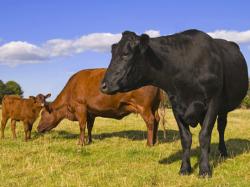Did You Know – Too Much Cow Or Milk?
September 6, 2016 | 3 min to read

It’s the expansion phase for the North American beef cow herd. For most farmers and ranchers, that means finding ways to increase the number of cows rather than the size of each. And of course, everybody’s talking about size – makes sense when you think about the escalating annual cost of keeping an average cow on the place.
Many things power that escalator, but higher land cost per cow might be the top step. For years, anywhere in the U.S. the average land investment per cow was in the $2,500 to $3,000 range. Today, driven in part by the ethanol impact on grain and subsequent farmland prices, that cost is three or four times higher, according to Texas A&M economist Stan Bevers. Land cost per cow was recently noted in the range of $7,500 to $12,500.
A bigger-than-average cow requires the upper-end cost.
How big are typical commercial cows today? A decade ago, using USDA cull-cow harvest weights, Cargill nutritionist Brian McMurry examined the trend in Feedstuffs magazine. From 1975 to 2005, cow size increased by more than 300 lb., from 1,047 to 1,369. As you can see, that’s more than 30 lb. per year. In the past 10 years this author would suggest we’ve slowed the rate some, but surely added at least another 50 lb. to arrive at an average of more than 1400 lb.
So how much of an impact does cow size have on pasture needed per cow? Scientists at North Dakota State University reported on research where 50 cows weighing 1216 lb. each required 529 acres or 10.5 acres/cow. Meanwhile, 50 cows weighing 1,571 lb. would need 642 acres or 12.8 acres/cow. That’s 6.3% more pasture per 100 lb. of cow weight.
Other research tells us a 100-lb. increase in cow size only nets 8 to 15 more pounds of weaned calf.
What’s driving weights higher? That answer is easy. We have totally changed today’s beef cow. She calves easier, milks more, weans a bigger calf in fewer days and, for the most part, she’s a more functional cow. Clearly, she’s bigger; that’s the result of applied genetic selection for growth.
Since most cows contain some Angus genetics, the trend in that breed’s growth EPDs (expected progeny differences, see charts) helps explain the change over time. Like many other producers, Angus breeders were uneasy about the 30-lb. annual weight increases 20 years ago, so they used EPDs to moderate mature cow size while selecting for growth.
You may think bigger cows are the big problem, but there’s more to consider, including some that you likely DID NOT KNOW:
For one thing, big is not all bad, as the amount of beef per cow continues to grow. We’ve added an average of 5 lb. of carcass weight per year to the grain-fed progeny of those cows across 30 years.
During this summer’s Beef Improvement Federation meetings, Colorado State University geneticist Mark Enns said, “At the rate we’re going, by 2030 we will be selling 1,560-lb. steers as an average, which equates to a 975-lb. carcass.”
Cow size gets all the attention because it’s pretty easy to track, but we really should be talking about milk production, which we have greatly increased in these cows. My geneticist friends see no end to selection for milk or growth in the near future.
Dietary guidelines suggest a 100-lb. increase in cow size drives energy needs by 6% to 8%, which fits the North Dakota pasture example. But a 5-lb./day increase in milk production increases the TDN (total digestible nutrients) needed by 10%, and crude protein by another 13% to 15%. That says the level of milk production merits much more attention than it usually gets when selecting the perfect cow for each farm or ranch.
Talk about it, do something about it, but don’t lose sight of the impact of any changes on consumer demand for beef. An excellent review recently published by Scott Greiner and Jason Smith at Virginia Tech helps put this in context. They conclude on the basis of all available research, that selection for marbling has no effect on birth weight, calving ease, age at puberty, heifer pregnancy, calving interval OR MATURE COW SIZE.
They do note a slightly positive correlation between marbling and milk production but point out that the size and variation in the Angus genetic database allow selection for more or less milk as dictated by forage resources available, with simultaneous and continued selection for marbling.
Source: Certified Angus Beef LLC
